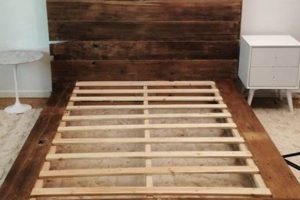A do-it-yourself method for displaying artwork, photographs, or other flat objects that creates the illusion of the item floating within the frame itself. The technique typically involves mounting the item between two panes of glass or acrylic, with a border around the edges that is free from obstruction. The result highlights the displayed item without visual interference from traditional frame elements, enhancing its aesthetic appeal.
This framing approach offers several advantages, including a modern and minimalist aesthetic that complements various interior design styles. The lack of a traditional frame edge draws more attention to the art itself, minimizing distractions. Historically, techniques resembling this type of display have been utilized in museums and galleries to showcase delicate or important items, providing both protection and an unobstructed viewing experience. The method’s accessibility through do-it-yourself projects has broadened its appeal to a wider audience.
Subsequent sections will delve into specific materials and methods employed to construct these displays, offering guidance on selecting appropriate glass or acrylic thicknesses, attachment methods, and potential design variations to achieve the desired visual effect. Considerations for preserving and protecting the enclosed object will also be addressed, ensuring longevity and preventing damage.
Construction Recommendations
The following recommendations provide guidance for the successful construction of a do-it-yourself display.
Tip 1: Material Selection. Opt for UV-resistant acrylic or conservation-grade glass to prevent fading and damage to the displayed item. Carefully assess the thickness required to support the size and weight of the artwork.
Tip 2: Precise Measurement. Accurate measurements of the artwork and framing materials are critical. Employ precise cutting tools to ensure clean edges and proper alignment of the glass or acrylic panes.
Tip 3: Edge Treatment. Smooth and polish the edges of the glass or acrylic to prevent sharp edges and ensure a professional finish. Consider using edge sealant to prevent moisture infiltration.
Tip 4: Mounting Method. Utilize archival-quality, acid-free adhesives or spacers to secure the artwork within the frame. Ensure the adhesive is compatible with both the artwork and the framing materials.
Tip 5: Proper Sealing. Seal the perimeter of the display to prevent dust and moisture from entering. Silicone sealant or specialized framing tape can be employed for this purpose.
Tip 6: Adequate Spacing. Maintain a consistent space between the artwork and the frame’s inner edges to achieve the intended floating effect. Spacers or small shims can assist in maintaining uniform spacing.
Tip 7: Secure Hanging. Install appropriate hanging hardware, such as D-rings or wire, that is capable of supporting the weight of the assembled display. Ensure the hardware is securely attached to the frame’s backing.
Adhering to these recommendations will contribute to a visually appealing and durable display, preserving the artwork for extended periods.
The concluding section will offer insights into long-term care and maintenance practices, ensuring the continued preservation of the framed artwork.
1. Material Selection
Material selection is a critical determinant of both the aesthetic quality and preservation capabilities of a self-assembled, seemingly unsupported display. The choice of glass or acrylic directly impacts the artwork’s visibility, protection from ultraviolet radiation, and the structural integrity of the overall frame. For instance, using standard, non-UV-filtered glass can lead to the fading of pigments in a photograph or painting over time. Conversely, employing museum-quality, UV-resistant acrylic, though potentially more expensive, mitigates this risk, thereby extending the artwork’s lifespan. The thickness of the chosen material also influences the frame’s stability, particularly with larger pieces, preventing warping or breakage. This selection dictates not only the visual impact but also the long-term care requirements of the displayed artwork.
Further considerations include the clarity and refractive index of the material. High-clarity acrylic, for example, offers superior light transmission compared to standard glass, enhancing the artwork’s vibrancy. The type of adhesive used for mounting also constitutes a material selection decision with significant implications. Acid-containing adhesives can degrade paper-based artworks, necessitating the use of archival-quality, acid-free alternatives. Practical application examples demonstrate the importance of these choices. A deteriorated photograph in a frame using inadequate materials underscores the consequence of neglecting appropriate material specifications. Properly selected materials, conversely, ensure the art remains protected and vibrant for decades.
In summary, material selection is not merely a superficial consideration in the construction of a self-assembled display; it is a foundational element that dictates the artwork’s longevity and visual appeal. Challenges in material selection often stem from balancing cost with conservation needs. Ultimately, informed decisions regarding materials are crucial for ensuring the artwork is both showcased effectively and preserved for future enjoyment.
2. Accurate Dimensions
In the construction of a self-assembled display, accurate dimensions serve as a foundational prerequisite for a successful outcome. Dimensional precision dictates the overall aesthetic and structural integrity of the finished piece. A miscalculation in the size of the glass or acrylic panels, for instance, results in an ill-fitting frame, negating the intended floating effect. This misalignment can compromise the visual presentation, detracting from the artwork itself. Furthermore, inaccurate measurements may lead to instability, increasing the risk of damage to the artwork during assembly or subsequent handling. The cause-and-effect relationship is direct: precise measurements yield a professional-looking, secure display, while dimensional inaccuracies compromise both aesthetics and structural safety.
The importance of accurate dimensions extends beyond the external frame components. The internal spacing between the artwork and the frame’s edges must also be precisely calculated and executed. Uneven spacing disrupts the visual illusion of floating and can appear amateurish. Consider a scenario where the artwork is a valuable photograph. Improperly sized materials, leading to inadequate sealing, may expose the photograph to environmental contaminants, accelerating its degradation. Conversely, a well-executed display, with precisely measured components, ensures proper sealing, protecting the photograph from such damage. The selection of appropriate spacers and mounting materials also hinges on dimensional accuracy, ensuring the artwork is securely held in place without undue stress or distortion.
In conclusion, accurate dimensions are not merely a procedural step in constructing a self-assembled display; they are a fundamental requirement for achieving the desired visual effect and ensuring the artwork’s preservation. Challenges in achieving this precision often stem from using inadequate measuring tools or neglecting to account for material thicknesses. However, the practical significance of dimensional accuracy cannot be overstated. It dictates the final presentation, protects the enclosed artwork, and ultimately defines the success or failure of the entire project.
3. Edge Finishing
Edge finishing plays a critical role in the construction of a self-assembled, seemingly unsupported display, influencing both the aesthetic quality and the structural integrity of the finished product. The treatment of the edges of the glass or acrylic panels directly impacts the perceived quality and safety of the frame.
- Safety and Handling
Unfinished glass or acrylic edges present a significant safety hazard. Sharp edges pose a risk of cuts during assembly and subsequent handling. Edge finishing, through processes such as sanding, grinding, or polishing, eliminates these sharp edges, rendering the frame safer to handle. In a practical context, a frame with unfinished edges may cause injury during cleaning or relocation, highlighting the importance of this process.
- Aesthetic Appeal
Finished edges contribute significantly to the overall aesthetic appeal of the display. Polished edges create a clean, refined look, enhancing the visual presentation of the artwork. Conversely, rough or chipped edges detract from the artwork, creating a less professional appearance. Edge finishing transforms the frame from a utilitarian object to a visually pleasing element that complements the artwork.
- Structural Integrity
Proper edge finishing can improve the structural integrity of glass or acrylic panels. Smoothing the edges reduces stress concentrations, minimizing the risk of cracks or chips. This is particularly important for larger frames or those subject to frequent handling. Well-finished edges contribute to the frame’s longevity and resistance to damage.
- Light Transmission and Reflection
The finish on the edges of the glass or acrylic influences how light is transmitted and reflected within the frame. Polished edges allow for greater light transmission, enhancing the visibility of the artwork. Conversely, frosted or beveled edges can create interesting visual effects by scattering or refracting light. This allows for customization of the display’s appearance to suit the artwork and surrounding environment.
In summary, edge finishing is not merely a cosmetic detail in the construction of self-assembled displays. It is a critical process that enhances safety, improves aesthetics, increases structural integrity, and influences light transmission. Neglecting edge finishing compromises the quality and safety of the frame, detracting from the overall presentation of the artwork. A well-executed edge finish elevates the frame, transforming it into a seamless and visually pleasing element of the display.
4. Secure Mounting
Within the context of a do-it-yourself floating display, secure mounting represents a critical element influencing both the aesthetic outcome and the preservation of the enclosed artwork. The very nature of these displays, with the art seemingly suspended between transparent panels, necessitates a robust and discreet mounting strategy. Failure to adequately secure the artwork results in shifting or slippage, compromising the intended visual effect and potentially causing physical damage to the artwork itself. The choice of mounting materials and techniques directly affects the long-term stability and presentation of the display. For instance, using non-archival adhesives can lead to discoloration or degradation of paper-based artwork over time. The causal relationship is evident: proper secure mounting ensures aesthetic integrity and artwork preservation; inadequate mounting jeopardizes both.
Several methods exist for achieving secure mounting, each with its own advantages and disadvantages. Acid-free adhesive tabs or corners provide a non-invasive option for attaching the artwork to the backing panel. These methods allow for reversibility, which is particularly important for valuable or sensitive pieces. Alternatively, specialized spacers can be employed to create a physical barrier between the artwork and the glass or acrylic, preventing direct contact and potential sticking. The selection of the appropriate mounting method depends on the type of artwork, its size and weight, and the desired level of permanence. A practical example involves framing a delicate watercolor painting. Direct application of adhesive could damage the painting; therefore, using archival-quality corners and spacers would be a more suitable approach, ensuring both security and preservation.
In conclusion, secure mounting is not merely a procedural step in constructing a floating display; it is a fundamental requirement that dictates the artwork’s long-term stability and visual presentation. Challenges in achieving secure mounting often arise from selecting inappropriate materials or employing techniques that are not suitable for the specific artwork being framed. The practical significance of understanding these principles cannot be overstated, as it directly impacts the preservation and aesthetic value of the displayed piece. Implementing proper mounting strategies ensures the artwork remains securely positioned, preserving its integrity and enhancing the overall visual impact of the display.
5. Aesthetic Spacing
Aesthetic spacing, in the context of self-assembled transparent displays, constitutes a fundamental design element that significantly influences the perceived visual impact of the enclosed artwork. The strategic manipulation of space between the artwork and the surrounding frame components creates the illusion of suspension, a defining characteristic of this style. Incorrect spacing can negate this effect, resulting in a visually disjointed or cramped presentation. The cause-and-effect relationship is direct: deliberate and proportionate spacing enhances the sense of flotation and highlights the artwork, while inadequate or inconsistent spacing detracts from the overall aesthetic.
The importance of aesthetic spacing extends beyond merely creating the illusion of suspension. It contributes to the visual breathing room around the artwork, preventing it from feeling confined or overwhelmed by the frame. This allows the viewer to focus on the artwork itself, free from visual distractions. Real-life examples illustrate this point. A photograph displayed with minimal spacing between the image and the frame’s edge appears cramped and less visually appealing than the same photograph displayed with a well-considered border. Furthermore, variations in spacing can be employed to subtly alter the perceived scale or orientation of the artwork. For instance, increasing the spacing along one side of the artwork can create a sense of asymmetry, adding visual interest to the display.
In conclusion, aesthetic spacing is not simply an arbitrary design choice within the construction of self-assembled transparent displays; it is a critical component that directly impacts the visual effectiveness and overall aesthetic appeal. Challenges in achieving optimal spacing often stem from a lack of planning or a failure to consider the specific characteristics of the artwork being displayed. However, understanding the principles of spacing and its effect on visual perception is essential for creating displays that both showcase and enhance the enclosed artwork, ultimately fulfilling the design’s intended purpose.
6. Proper Sealing
In the context of a do-it-yourself seemingly unsupported display, proper sealing constitutes a critical safeguard against environmental contaminants that can compromise both the artwork and the frame components. The inherent design, which features transparent panels encasing the artwork, necessitates a hermetic or near-hermetic seal to prevent the ingress of dust, moisture, and pollutants. The absence of adequate sealing mechanisms leads to the accumulation of particulate matter within the frame, obscuring the artwork and detracting from its visual clarity. Furthermore, moisture infiltration fosters the growth of mold and mildew, accelerating the degradation of paper-based artwork and promoting corrosion of metallic components. The relationship is straightforward: proper sealing preserves artwork integrity and maintains visual clarity; deficient sealing precipitates damage and visual degradation.
The methods employed for achieving effective sealing vary, ranging from the application of specialized framing tape to the use of silicone sealants. The selection of an appropriate sealing method depends on the materials used in the frame’s construction, the desired level of permanence, and the environmental conditions to which the display will be exposed. For instance, a frame constructed from acrylic panels may benefit from the use of a flexible silicone sealant, which accommodates dimensional changes caused by temperature fluctuations. A practical example involves a photograph displayed in a humid environment. Without proper sealing, moisture can penetrate the frame, causing the photograph to warp, stick to the glass, or develop mold growth. Conversely, a well-sealed frame protects the photograph from these environmental hazards, ensuring its long-term preservation and visual appeal.
In conclusion, proper sealing is not merely a procedural step in the creation of a seemingly unsupported display; it is a fundamental requirement that dictates the artwork’s longevity and the frame’s visual integrity. Challenges in achieving effective sealing often stem from using inappropriate materials or failing to properly prepare the frame surfaces. However, understanding the principles of sealing and its impact on artwork preservation is essential for creating displays that protect and showcase the enclosed artwork. Applying appropriate sealing techniques ensures the frame remains free from contaminants, preserving the artwork’s integrity and maintaining the display’s intended visual impact over time.
Frequently Asked Questions
The following addresses common inquiries regarding the construction, application, and preservation aspects of self-assembled frameless displays. These responses aim to clarify key considerations for achieving professional-quality results and ensuring the longevity of displayed artwork.
Question 1: What type of glass or acrylic is most suitable for constructing a frameless display?
Conservation-grade glass or UV-resistant acrylic is recommended to mitigate potential damage from ultraviolet radiation. The thickness of the chosen material should be proportionate to the size of the artwork to prevent warping or breakage.
Question 2: How can one ensure the artwork is securely mounted within the frameless display?
Archival-quality, acid-free adhesives or spacers are recommended to prevent discoloration or degradation of the artwork. The mounting method should be non-invasive and reversible, particularly for valuable or sensitive pieces.
Question 3: What techniques are effective for achieving a seamless and visually appealing edge finish?
Sanding, grinding, or polishing the edges of the glass or acrylic panels is crucial for eliminating sharp edges and enhancing the aesthetic quality. Edge sealant can further protect against moisture infiltration.
Question 4: How can one prevent dust and moisture from entering the frameless display?
Applying specialized framing tape or silicone sealant along the perimeter of the display creates a barrier against environmental contaminants. Ensuring a tight seal is essential for preserving the artwork and maintaining visual clarity.
Question 5: What considerations are important for achieving the desired floating effect?
Maintaining a consistent and proportionate space between the artwork and the frame’s inner edges is crucial for creating the illusion of suspension. Spacers or shims can assist in maintaining uniform spacing.
Question 6: How should the completed frameless display be properly supported and hung?
Installing appropriate hanging hardware, such as D-rings or wire, is necessary to support the weight of the assembled display. The hardware must be securely attached to the frame’s backing, and the hanging mechanism should be capable of bearing the load.
In summary, the creation of visually compelling and protective frameless displays requires careful attention to material selection, mounting techniques, edge finishing, sealing methods, aesthetic spacing, and support mechanisms.
The subsequent section will explore long-term care and maintenance strategies for these types of displays.
Conclusion
The preceding discussion has provided a comprehensive examination of the do-it-yourself seemingly unsupported display method. Key aspects, including material selection, dimensional accuracy, edge finishing, secure mounting, aesthetic spacing, and proper sealing, have been identified as critical determinants of the final product’s visual appeal and the long-term preservation of enclosed artwork. The information presented serves as a guide for those seeking to create displays that are both aesthetically pleasing and protective.
A well-executed project requires careful planning and meticulous execution. The knowledge gained from this exploration of these displays should inform future endeavors in this area, ensuring that creative efforts result in displays that enhance and safeguard valuable artwork for years to come. Prudent application of these principles will advance the appreciation and preservation of art through this versatile display method.







